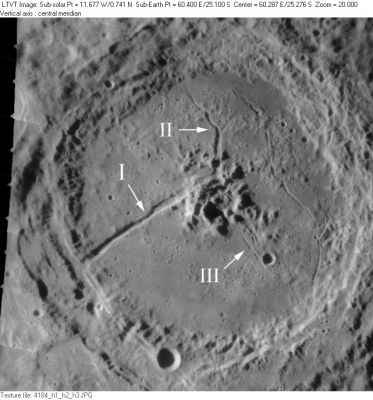Rimae Petavius
Contents
Rimae Petavius
|
Lat: 25.9°S, Long: 58.9°E, Length: 80 km, Depth: km, [/R%C3%BCkl%2059 Rükl 59] |


Left: LO-IV-184H Aerial view indicating the Roman-numeraled rilles of the [/System%20of%20Lunar%20Craters System of Lunar Craters]. Right: Colin Evans Earth-based view.
Table of Contents
Images
LPOD Photo Gallery Lunar Orbiter Images Apollo Images
Maps
([/LAC%20zone LAC zone] 98D2) LAC map Geologic map
Description
Description: Elger
([/IAU%20Directions IAU Directions]) PETAVIUS.--The third member of the great meridional chain: a noble walled-plain, with a complex rampart, extending nearly 100 miles from N. to S., which encloses a very rugged convex floor, traversed by many shallow valleys, and includes a massive central mountain and one of the most remarkable clefts on the visible surface. ... There is a remarkable bifurcation of the border S. of [/Wrottesley Wrottesley]. A lower section separates from the main rampart and, extending to a considerable distance S.W. of it, encloses a wide and comparatively level area which is crossed by two short clefts. ... The great cleft, extending from the central mountains to the S.W. wall, and perhaps beyond, was discovered by Schroter on September 16, 1788, and can be seen in a 2 inch achromatic. In larger instruments it is found to be in places bordered by raised banks.
Description: Wikipedia
Additional Information
The railroad at the southwestern part of the rim of Petavius
- I can't imagine it's a totally new discovery, this railroad-like feature on the southwestern part of the rim of Petavius. What is it? It seems to start just east of Wrottesley (the crater which is touching the west-northwestern part of the rim of Petavius) and it runs all the way to the southeast through the bowl-shaped crater Petavius C, and... much further across the unimpressive craters Hase and Hase D, until it meets Rimae Hase (or... are the railroad and Rimae Hase perhaps one and the same feature?). - DannyCaes DannyCaes Jan 7, 2016
Nomenclature
- Named for the crater ([/Petavius Petavius]) within which the rilles are found.
- The current status of lunar rille names in the [/IAU%20nomenclature IAU nomenclature] is very unclear since the IAU never followed through on its [/IAU%20Transactions%20XVB 1973 promise] to give rille systems "new and more appropriate designations." Instead, the [/IAU%20Planetary%20Gazetteer IAU Planetary Gazetteer] has so-far only lumped the old Roman-numeraled rilles together as "Rimae". In the present case, the original IAU nomenclature of [/Blagg%20and%20M%C3%BCller Blagg and Müller] (1935), had only a single rille: Elger's "great cleft", labeled "I" in the illustration above. The [/System%20of%20Lunar%20Craters System of Lunar Craters] added "II" and "III"; although the preparers of LAC 98 (also approved by the IAU), labeled "III", but combined "I" and "II" into a single Rima Petavius. The [/System%20of%20Lunar%20Craters System of Lunar Craters] also draws the rille paralleling the west rim of [/Petavius Petavius] as a sort of huge T-shaped extension of "I", but it is not clear from the drawing if it was meant to be included in the name. - JimMosher JimMosher
LPOD Articles
Trenchant Observations on a Trench. On the Limb Again. LPOD (Repeat of 3/7/2006 A Bend in the Middle Moderate Sun over a Magnificent Crater On the Limb Again A New Kind of DHC Petavius Naked Petavius: Rilles & Volcanic Spots Four in a Row Limb Gift
Bibliography
- [/A%20Portfolio%20of%20Lunar%20Drawings A Portfolio of Lunar Drawings] (Harold Hill), see: the first drawing in that book, on a number-less page.
This page has been edited 1 times. The last modification was made by - tychocrater tychocrater on Jun 13, 2009 3:24 pm - afx3u2